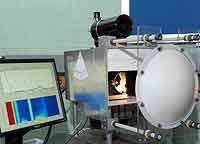A system developed at the US Department of Energy's Argonne National Laboratory can covertly detect chemical plumes at great distances.
The passive millimetre-wave spectroscopy (PmmWS) system was pioneered by Sami Gopalsami, Sasan Bakhtiari, Paul Raptis and Thomas Elmer, all of Argonne's Nuclear Engineering Division.
The system has the capacity to identify chemical plumes at ranges of up to a few kilometres and at concentrations as low as 100-1000 parts per million (ppm).
The Argonne team designed the PmmWS system primarily to monitor chemical signatures emitted by processing facilities suspected of unauthorised nuclear activity. Certain chemical fingerprints can identify factories involved in the enrichment and reprocessing of nuclear materials and their use in weapons production.
The researchers' ability to collect remote data passively, using an infrared camera, as opposed to actively, using a radar, provides it with a stealthy advantage - namely, it's tough to detect when it is in use.
This new system also possesses several other advantages over other forms of chemical sensing. Previous remote sensing instruments for terrestrial, as opposed to astronomical, use had lower ranges of detection (ranging from 10m to 100m), were susceptible to interference from clouds and other atmospheric phenomena, and cost more than the PmmWS system.
Compared to it predecessors, the Argonne system is also safer and offers better selectivity – that is, it can identify a particular molecule instead of just a molecular functional group.

Tests of the millimetre-wave spectroscope were conducted at a Nevada test site, shown here. Housed in a bunker (inset, right) several hundred metres from the test site (centre), the spectrometer was able to distinguish the signal of gas plumes (represented by the green spiral) from the background mountains




Labour pledge to tackle four key barriers in UK energy transition
I'm all for clarity and would welcome anyone who can enlighten me about what Labour's plans are for the size and scale of this Great British Energy....